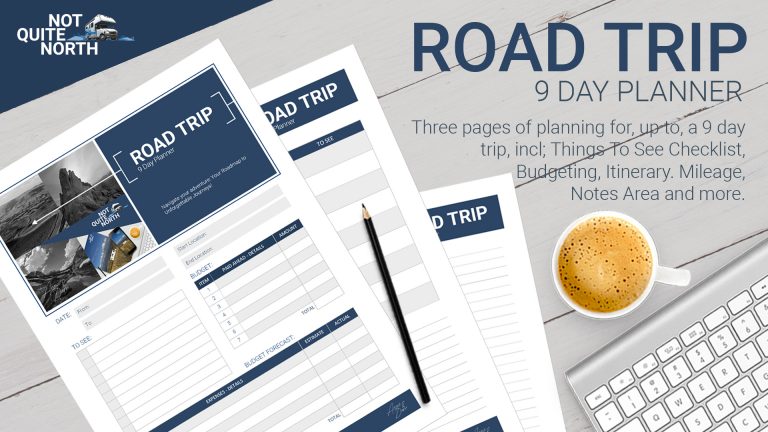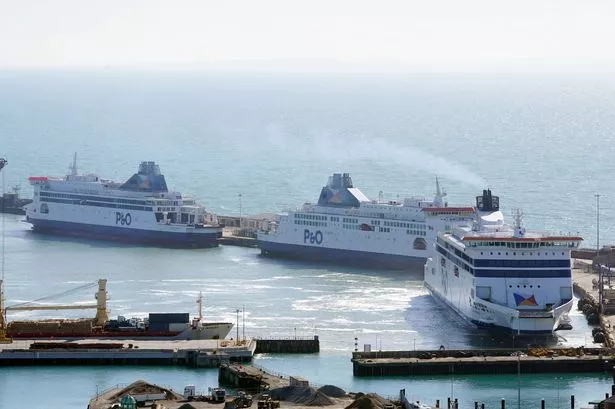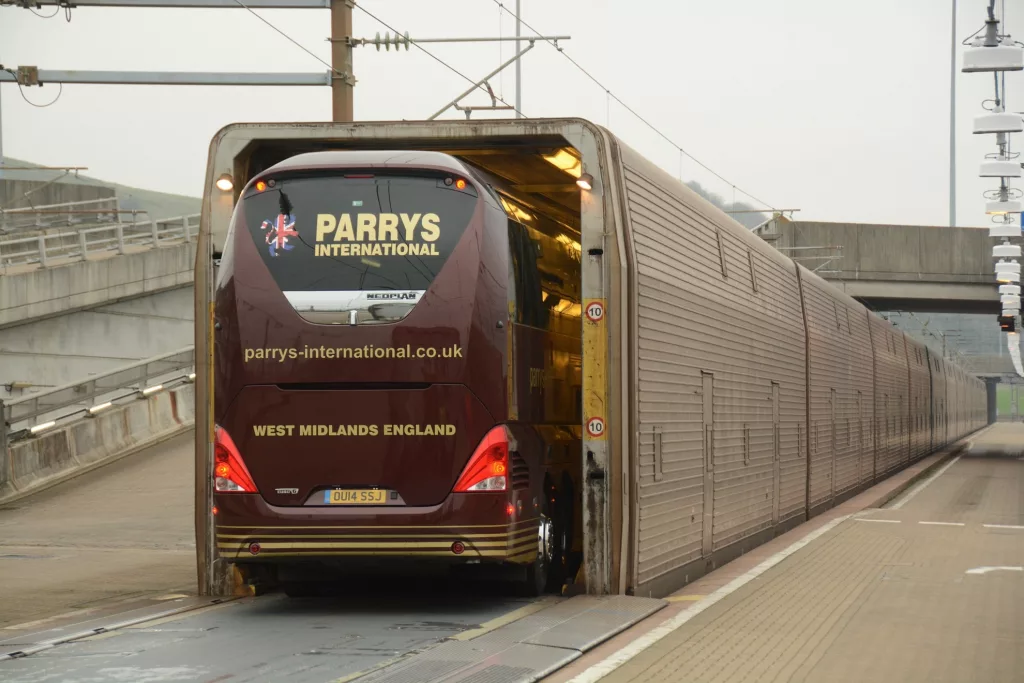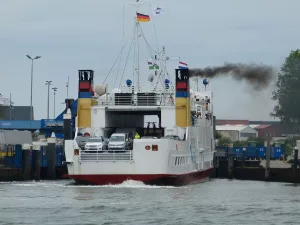Taking the Ferry or Eurotunnel with a Motorhome?
The Pro's and Cons of Taking the Eurotunnel or Ferry to get to Europe.
If you are driving to Europe this year, the first thing that is going to happen after knowing when you are going is likely to be ‘How am I going to get there? Shall I take the Ferry or Eurotunnel a motorhome?’.
It is something we searched for a lot in our earlier days of travelling to Europe. We know it is useful to have everything in one place for you to read. Because it would have been super useful for us!
Weighing up all the information we could find, and our experience, this article will to allow you to make an informed choice about the best way for you to get your motorhome over to mainland Europe to start your epic roadtrip adventures.
Eurotunnel or Ferry? - Jump to ...
Download our Handy Road Trip Planner
Use our handy ready made PDF planner to help you plan your trip. We created a 9 day planner to use to plan a 1 week trip. Simply print out more copies for each week of your travels. Capture everything you need from your start and end points to where you will stay. There is space to write all the things you want to see and more. Plenty of room for jotting down notes as you plan too.

*Road Trip Planner
*By downloading our planner, you give us permission to send you our newsletter. We send this approx every 6 – 8 weeks.
Taking the Eurotunnel or Ferry - All the Routes!
A visual display of all the ferry routes from the UK to mainland Europe is a really useful planning tool. When faced with the choice of taking the ferry or Eurotunnel with a motorhome, this map can help you make that decision. All the ferry routes are for onward motorhome or car travel going south, not towards Scandinavia.
*Data correct at time of writing (2024)
Use two fingers to move around the map. If you want to reduce the options available to you, click the small menu at the top left and you can uncheck items. For example, if you know you are going to France, you can uncheck all the other boxes on the map and it will reduce the amount of routes shown on the map above.
Ferry or Eurotunnel -Time of Travel Tips
When we were booking our ferry and doing the research for this article there were some simple cost saving tips on time of travel. If you decide to use the ferry over the Eurotunnel with your motorhome, the crossing is cheaper if you travel in the daytime rather than taking an overnight ferry. Where as if you decide to use the Eurotunnel with your motorhome to get to France, then the crossing is more expensive early mornings, dropping as you get further into the day.
Travelling by Ferry
Advantages
Scenic and Relaxing: Ferries offer a more scenic route, albeit a lot of it is sea! This can be a much more relaxing start to you road trip, and also a good break from driving, depending on where your original start point was.
Onboard Amenities: Ferries generally have more amenities such as restaurants, shops, and sometimes entertainment options, making the journey more comfortable, especially on longer crossings.
No Vehicle Restrictions: Ferries can accommodate almost any size of motorhome, without the height and length restrictions that apply in the Eurotunnel.
Direct Access to Different Ports: Ferries can take you directly to various ports in France (such as Calais, Dieppe, Le Havre, Cherbourg, etc.), providing more options depending on your destination in France or Europe.
Disadvantages
Longer Journey Times: Ferry crossings generally take longer than the Eurotunnel, which could add hours to your travel time depending on the route.
Weather Dependent: Ferry schedules can be affected by bad weather, potentially leading to delays or cancellations.
Less Frequent Departures: Depending on the route and the season, ferry departures may not be as frequent as Eurotunnel departures, requiring more planning and potentially longer waiting times.
Travelling with Pets: If you have pets, then they will either be restricted in the motorhome with no access to them, in a kennel, with limited access or with you in one of the few pet cabins.
Travelling by Eurotunnel
Advantages
Speed: The Eurotunnel crossing from Folkestone to Calais takes only 35 minutes, making it the fastest way to cross the Channel.
Frequency: Departures are very frequent, with up to four shuttles per hour, reducing waiting time significantly.
Less Affected by Weather: Since the travel is underground, it is less likely to be affected by weather conditions compared to ferries.
Ease and Convenience: The check-in process is quick (arrive 45 minutes prior to departure), and you stay with your vehicle throughout the crossing.
Travelling with Pets: They can stay with you on the Eurotunnel and you can take more of them! The limit at time of writing was 8.
Disadvantages
Limited to Calais: The Eurotunnel only takes you to Calais, which may not be ideal if your destination is closer to another French port.
Vehicle Restrictions: There are restrictions on the type of gas containers you can carry, which might affect motorhome travelers who rely on propane or butane.
Less Scenic: There’s nothing much to see during the crossing as you are inside a shuttle in the tunnel.
Cost: While both ferry and Eurotunnel prices vary greatly depending on time of booking and availability, Eurotunnel can often be more expensive, especially during peak times.
Location: Travel time to get to Folkestone may be several hours depending on your starting point.
Delays: Delays on the roads around Folkestone at peak times can be pretty horrendous.
Consider also where you are going when you get to France. There are so many ferries in the south of France, that the relaxing ferry trip arriving much closer to your destination might be more appealing.
Travelling by Ferry With Your Motorhome
Planning is really important when you are looking at how you are going to get over to mainland Europe with your motorhome. Our key tips will not only ensure you are nicely organised for your European road trip, but will save you money too.
Of course you may wish to hire a car for your roadtrip or a motorhome at your destination, in which case, we recommend using the following car hire company.
Book in Advance: Ferry routes can get booked up, especially in peak travel seasons, so it’s wise to book your tickets as early as possible.
Check Vehicle Requirements: Make sure your motorhome meets the size and weight restrictions for the ferry. Also, be aware of any additional charges for larger vehicles.
Arrive Early: Check-in times can vary, but arriving at least 90 minutes before departure is generally recommended.
Onboard Facilities: Overnight ferries often offer cabins, dining options, and entertainment, making the journey more comfortable. The daytime ferry allows you to have a variety of seating arrangements from the free seats (that’s where we sit!), to first class lounges, pre-booked meals in the restaurants or cabins to relax and lay down in. You can’t stay in your motorhome when you cross. They lock all the doors to the car decks so the vehicles are unreachable.

We found that the cost of joining the Camping & Caravanning Club (CCC) was more than offset when we booked our ferry crossing tickets using the CCC online booking. If you use the ferry even once a year, it is definitely worth joining the CCC.

Taking the Ferry to France With a Motorhome
France is a great place for motorhomers as it is accessible from so many areas across the south coast and the durations are very reasonable. The Dover to Calais ferry route is the shortest of the ferry routes to France, taking just 90 minutes. The longest ferry route to France with a motorhome is 11 hours, which is the Portsmouth to St Malo ferry route.
All of these routes are detailed on our interactive map. Download our free roadtrip planner and start jotting down any of the options that could be considerations for you.
Dover to Calais
- Operators: P&O Ferries, DFDS
- Journey Time: Approximately 90 minutes
- Details: This is the most popular route for quick trips to France, with services running 24/7. Facilities on board include restaurants, duty-free shops, and lounges.
- Pet Policy: Pets must stay in vehicles on both services. P&O offers a pet-friendly lounge (pre-booking required).
Dover to Dunkirk
- Operator: DFDS
- Journey Time: Approximately 2 hours
- Details: Less busy than Calais, this route is ideal for those heading to northern Europe. Facilities include a shop, café, and children’s play area.
- Pet Policy: Pets must remain in the vehicle throughout the crossing.
Newhaven to Dieppe
- Operator: DFDS
- Journey Time: About 4 hours
- Details: Connects the south of England directly to Normandy. Onboard facilities include restaurants, a shop, and comfortable lounges.
- Pet Policy: Pets must stay in the vehicle; there are no kennel facilities.
Portsmouth to Caen
- Operator: Brittany Ferries
- Journey Time: Approximately 6 hours
- Details: Offers both daytime and overnight crossings. Facilities include restaurants, bars, cinemas, and shops.
- Pet Policy: Pets can stay in vehicles, kennels, or pet-friendly cabins, with designated exercise areas on board.
Portsmouth to Le Havre
- Operator: Brittany Ferries
- Journey Time: The crossing takes approximately 5-8 hours, depending on the specific service (overnight sailings are typically longer).
- Details: This route offers both daytime and overnight crossings. Facilities included shops, bars, restaurants and comfy seating.
- Pet Policy: Pets can travel on this route. Brittany Ferries allows pets to stay in the vehicle or in pet-friendly cabins when booked in advance.
Portsmouth to Cherbourg
- perator: Brittany Ferries
- Journey Time: Fast-craft about 3 hours, conventional about 5 hours
- Details: Provides both fast and conventional services, with amenities such as bars, cafés, and cinemas.
- Pet Policy: Similar to Portsmouth to Caen.
Portsmouth to St Malo
- Operator: Brittany Ferries
- Journey Time: Approximately 11 hours, often overnight
- Details: The longest route, featuring extensive facilities including cabins, restaurants, pool, and shopping.
- Pet Policy: Pets can travel in vehicles, in kennels, or in designated pet-friendly cabins.
Plymouth to Roscoff
- Operator: Brittany Ferries
- Journey Time: About 6 hours
- Details: Offers a direct connection to Brittany. Facilities include restaurants, shops, and lounges.
- Pet Policy: Pets can stay in vehicles, kennels, or specific pet-friendly cabins.
Poole to Cherbourg
- Operator: Brittany Ferries
- Journey Time: Approximately 4.5 hours
- Details: This route provides a quick and efficient crossing to Normandy, France. The ferry offers comfortable amenities including a café-bar and duty-free shop.
- Pet Policy: Pets can travel on the ferry, provided they remain in the vehicle during the crossing. Visits during the journey can be arranged under staff supervision.
Taking the Ferry to the Netherlands with a Motorhome

This is our favourite route to take. We mostly take the Harwich to Hook of Holland route, because that is the one that is close to Norfolk and Suffolk. It works for us after we have said good bye to family and friends before we commence that years travels after getting our MOT done for the year.
DFDS Ferry from Newcastle to Amsterdam
- Operator: DFDS Seaways
- Journey Time: Approximately 15-16 hours
- Details: An overnight ferry with cabins, restaurants, bars, and entertainment options.
- Pet Policy: Pets can stay in vehicles, kennels, or pet-friendly cabins. Facilities are designed to ensure comfort during the crossing.
Stena Line Ferry from Harwich to Hook of Holland
- Operator: Stena Line
- Journey Time: About 6.5-7 hours for the day crossing and 9 hours overnight.
- Details: Connects directly to near Rotterdam, with amenities including cabins, restaurants, and free Wi-Fi.
- Pet Policy: Stena Line allows pets to travel in special pet cabins or pet kennels. Pets are not allowed to stay in vehicles or in kennels on board. You must book a pet ticket in advance, and certain conditions apply. Book in advance as the pet cabins are limited.
P&O Ferry from Hull to Rotterdam
- Operator: P&O Ferries
- Journey Time: Overnight crossing
- Details: Features comfortable cabins, dining options, and entertainment, making it suitable for longer journeys.
- Pet Policy: P&O Ferries allows pets on the Hull to Rotterdam route. Pets are not able to stay in the vehicle for the duration of the journey. You can book them into onboard kennels, if available but you can not check on them during the crossing. There are only 6 pet friendly cabins, so advance booking for pets is required, and there are additional charges.
Taking the Ferry to Belgium With a Motorhome
Belgium is a place that is very much forgotten when people are looking at ways to get to mainland Europe. It is actually pretty handy and good for travelling from the north and getting access easily to central Europe.
P&O Ferry from Hull to Zeebrugge
- Operator: P&O Ferries (Service may be subject to changes)
- Journey Time: Overnight crossing
- Details: The only direct route to Belgium, ideal for accessing central Europe. Cabins are available for overnight stays, and facilities include dining options and a bar.
- Pet Policy: Pets can stay in vehicles or in pet-friendly cabins; advance booking is required.
Taking the Ferry to Spain With A Motorhome
Yes, you can even catch the ferry to Spain from the UK. We have included Spain for completeness really. Although you won’t be comparing getting the ferry or Eurotunnel with your motorhome to Spain, that could be your end destination.
Brittany Ferries from Portsmouth to Bilbao
- Operator: Brittany Ferries
- Journey Time: Approximately 24-32 hours
- Details: Long-haul, direct route to the Basque region, with extensive onboard amenities including cabins, dining, and entertainment.
- Pet Policy: Pets can travel in designated pet-friendly cabins or kennels, with exercise areas and specific conditions.
Brittany Ferries from Portsmouth to Santander
- Operator: Brittany Ferries
- Journey Time: About 20-25 hours
- Details: Offers both comfort and convenience, with facilities such as restaurants, bars, and shopping available.
- Pet Policy: Similar to Portsmouth to Bilbao, with options for pets in vehicles, kennels, or cabins.
Brittany Ferries from Plymouth to Santander
- Operator: Brittany Ferries
- Journey Time: Approximately 20 hours
- Details: Less frequent than from Portsmouth but provides a direct route with full amenities.
- Pet Policy: Pets are allowed in vehicles, kennels, or pet-friendly cabins, with necessary bookings and conditions.

Tips for Travelling With Your Pet on the Ferry
We have detailed the things to check for travelling with your dog or cat on the ferry. There are common themes, so we thought we would pull these together in one easy to read section.
As we saw from looking at all the pet options, each ferry company has specific rules regarding pet travel. Before you book your trip, check their policy to understand the requirements. Some ferries allow pets to stay in the vehicle depending on what type of pet it is. Others provide kennels, and a few have pets in the passenger areas or cabins, albeit very limited numbers.
Make sure you have the necessary documentation required by the ferry company (or train) and also be sure to book in a vets appointment before hand. Only you know how your pet travels, so they could get sea sick/motion sickness. Get them some medication to help which you can give before the crossing. Also, avoid feeding your pet before the crossing as this should reduce any sickness they might have.
It is better to turn up early than be there at the last minute as this will allow you to exercise your pet before hand if appropriate and run off any surplus energy! If you are having to put your pet in the kennels, it can really help them if you take blankets or toys that they are familiar with. These known smells and objects will help to comfort them or make the space less stressful for them.
If you have a cat that you are leaving in the motorhome/campervan, make sure you have left it well ventilated and not too warm. You won’t be able to visit your pet during the crossing, so be sure they are firmly secured and not able to escape.
These tips will help make your ferry crossing for your European road trip a more pleasant and stress-free experience for your pet. It’s all about preparation, thinking ahead and making sure their needs are met throughout the journey.
Travelling by Eurotunnel With Your Motorhome
Read our key tips and things to consider when thinking about taking your motorhome to Europe by Eurotunnel.
Height and Length Restrictions: The Eurotunnel accommodates vehicles of various sizes, including motorhomes and campervans. However, pricing is based on the length and height of the vehicle, so it’s essential to provide accurate dimensions when booking. Motorhomes over 1.85 meters in height are considered high vehicles, and those over a certain length incur additional charges. You pay per metre over
Weight Restrictions: If your motorhome is over 3.5 tonnes you need to contact them first before booking your ticket.
Booking: It’s advisable to book your crossing in advance, especially during peak travel periods. You can book online, and you’ll need to specify the type and dimensions of your motorhome.
Check-in: Ensure you arrive at least 45 minutes before your departure (but no more than 2 hours early) to allow for check-in and any necessary security checks. Flexi-tickets allow you priority boarding.
Onboard the Shuttle: During the crossing, you’ll stay with your vehicle in the well-ventilated shuttle carriages. There are no onboard facilities like toilets during the short crossing, so use the terminal facilities before boarding.
Traveling with Pets: The Eurotunnel is pet-friendly, allowing you to bring dogs, cats, and ferrets on your trip. Pets need their own ticket, and you must comply with the Pet Travel Scheme requirements, including microchipping, vaccinations, and documentation.

Eurotunnel Ticket Cost Comparisons
Cost is a key factor when deciding whether the ferry or Eurotunnel is best with your motorhome. We decided to look at three different months to compare prices. The details we have entered are:
- Fiat Ducato Motorhome under 3.5T (Which ours isn’t, but for research purposes that is what we have used)
- The last week of that month (Sat – Sat leaving at noon)
- Bikes on the back
- 7m in length
- 1 dog
- Diesel fuel
- Return standard ticket booked
May - £600
Because the trip is only 6 weeks away the range of available tickets is limited. This added an extra £200 to the cost (which would have been £800).
August - £566
All ticket types were available for this booking. As with all the bookings, no insurance or breakdown cover was selected.
January - £337
November and January are the cheapest months to go by Eurotunnel with a motorhome.
To be honest, it is not a huge amount of difference in the costs between the months. The big difference comes in ticket type. The standard refundable ticket, is just an extra £80 – £100 whilst the flexi-ticket comes in at almost twice the price, so a trip in May would have been £1100, which is certainly costly.
The actual crossing on a the Eurotunnel is faster than taking the Dover to Calais ferry. When deciding whether to take the Eurotunnel or ferry to France, this is definitely one of the considerations to have in mind. Time does matter in our busy lives. Especially if you are on a holiday with a fixed amount of time, then trying to weigh up the Ferry or Eurotunnel conundrum, this is a factor.
As mentioned in the advantages and disadvantages, location the other side is also a bit thing. Be sure to weigh up the travel getting to and from the Eurotunnel when you are calculating times and prices.
Travelling via the Eurotunnel with a motorhome can offer a blend of speed and convenience depending on your starting location. Its kind of cool to do that 35 minute crossing and feel your holiday has already begun!
Our Top FAQ's on Taking the Ferry or Eurotunnel
Which is faster, Eurotunnel or ferry when getting to France?
The Eurotunnel is significantly faster in terms of crossing time. The journey from Folkestone to Calais takes just 35 minutes on the shuttle. In contrast, the shortest ferry crossing (Dover to Calais) takes about 90 minutes. However, total travel time will also include check-in times and boarding, where Eurotunnel generally requires passengers to arrive at least 45 minutes prior to departure.
Is the Eurotunnel or ferry more cost effective for motorhomes?
The cost can vary widely based on season, booking time, and promotions. Ferries often offer more competitive rates and promotions, especially for larger vehicles like motorhomes. The Eurotunnel tends to be pricier, but it offers a faster and more frequent service. It’s best to compare prices online closer to your travel date.
Can I get discounts with using the Tesco Club Card on my Eurotunnel crossing to France?
If you own a Tesco club card and shop there, you can save up your club card points to use towards Eurotunnel tickets. You must have a Eurotunnel account to use them though.
Can I bring my pet on the Eurotunnel and ferries?
Yes, both the Eurotunnel and most ferries allow you to bring pets. In the Eurotunnel, pets can stay in the vehicle with you during the crossing. On ferries, pets may need to stay in the vehicle or in kennels, depending on the operator’s policy. There are usually additional charges and specific requirements for pet travel. You may be restricted on the number of pets that you can take on a ferry, but the Eurotunnel allow you to take up to 8.
Are there facilities for resting and eating during the Eurotunnel crossing?
On the Eurotunnel, the crossing is brief (35 minutes), and you stay in your vehicle, so there are no onboard facilities like toilets or cafes. Ferries, however, offer a range of amenities including restaurants, cafes, lounges, and sometimes shops and entertainment, making them more comfortable especially on longer routes.
How do weather conditions affect Eurotunnel or ferry crossings?
The Eurotunnel is generally less affected by weather conditions because it operates underground. Ferry crossings can be subject to delays or cancellations in case of bad weather. This makes the Eurotunnel a more reliable option in terms of adherence to schedule under typical weather conditions.
What are the restrictions for motorhomes on Eurotunnel or ferries?
Both the Eurotunnel and ferries have specific size and weight restrictions for motorhomes. The Eurotunnel allows vehicles up to 4.2 meters high and trailers up to 2.6 meters high. Ferries generally accommodate a wider range of vehicle sizes but it’s important to check specific restrictions with your ferry operator. Additionally, there may be restrictions on the types of gas bottles allowed (especially on the Eurotunnel). You need to call if you want to book the Eurotunnel and your motorhome is over 3.5T
How early should I arrive before my crossing?
For the Eurotunnel, it’s recommended to check in at least 45 minutes before your scheduled departure (but not more than 2 hours ahead). For ferries, you generally need to check in 45-60 minutes before departure, though this can vary by operator and route. If you have pets, the time required is longer.
Summary of Taking the Ferry or Eurotunnel with a Motorhome
Our article has taken you through all the key points and considerations of deciding on whether to choose the Eurotunnel or Ferry when looking at the transport options available to you when you are travelling to Europe.
The big key factors are cost, location of crossing point, plus your start and end points. Another influencer, could also be if you have pets or not.
We covered everything that we could think of with regards to weighing up the pro’s and cons of using the ferry or Eurotunnel with a motorhome to get to mainland Europe, but if you have any questions, please do let us know, by dropping us a line on Facebook, Instagram or by email.
Download our Handy Road Trip Planner
Use our handy ready made PDF planner to help you plan your trip. We created a 9 day planner to use to plan a 1 week trip. Simply print out more copies for each week of your travels. Capture everything you need from your start and end points to where you will stay. There is space to write all the things you want to see and more. Plenty of room for jotting down notes as you plan too.

*Road Trip Planner
*By downloading our planner, you give us permission to send you our newsletter. We send this approx every 6 – 8 weeks.
We hope you enjoyed this article and found it useful. If you found it useful, please do share with others using the share buttons below. If you think we have missed something – please do let us know. We read all our emails!

NOTE: This article may include affiliate links. When you click on an affiliate link in a page or post, at no cost to you, we may earn commissions.
All Our Road Trip Inspirations
As fulltime nomadic adventurers, we create road trips especially for you. We do the ground work, so you don’t have to.

A Weekend Visit to the Dutch Tulip Fields
Spending a weekend amidst the breathtaking beauty of the Dutch Tulip Fields, particularly around the

The North Wales Way Road Trip
The North Wales Way is one of the three road trips in Wales that makes

The Cambrian Way Road Trip in Wales
This segment of The Wales Way’ called the Cambrian Way, takes you through the dramatic




